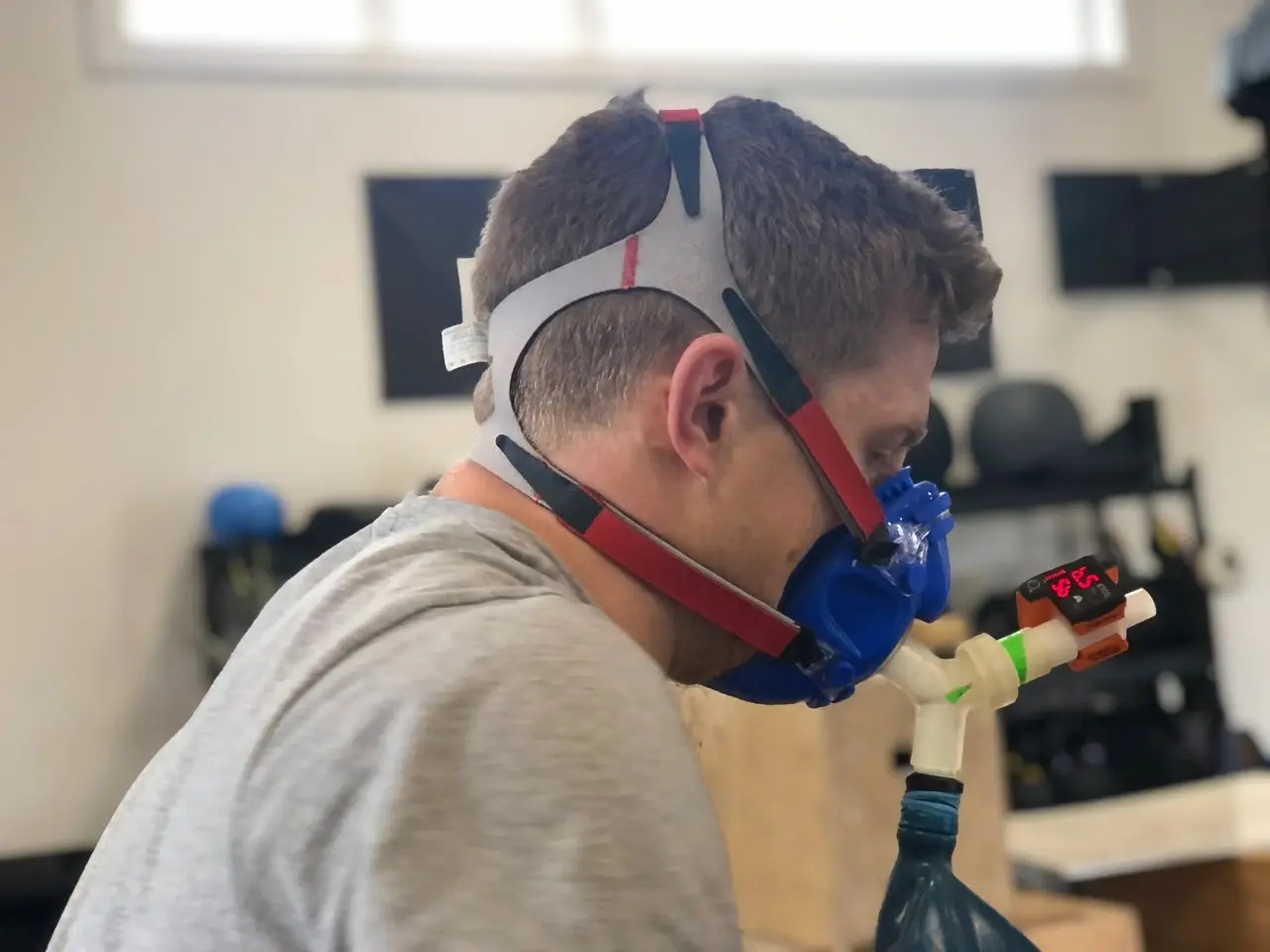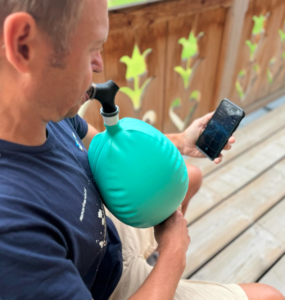By: Luke Way, ChPC
This is not a list of all the benefits of Isocapnic training, as that is an equally vast list. It’s a list of 20 common ideas of how Isocapnic sessions can be designed to specifically target different goals.
If you are wondering what you can do with the Isocapnic BWB, here is a good guide to get you rolling.
1. Learn to Breathe Efficiently

The Isocapnic Breathe Way Better (BWB) respiratory training device is a powerful tool designed to help individuals optimize the range of motion and coordination of their 15lbs of respiratory muscles. Unlike restrictive devices that limit airflow, the BWB provides an unrestricted breathing experience, allowing users to focus on enhancing their natural breathing patterns. This design is particularly beneficial for teaching proper technique, as it allows the diaphragm, intercostals, and other respiratory muscles to move through their full range without hindrance.
By maintaining isocapnic conditions—where the levels of carbon dioxide are kept constant—the BWB encourages more effective and controlled breathing exercises. This helps in activating and strengthening the respiratory muscles, improving their coordination and efficiency. The device ensures that users can perform breathing exercises at their own pace, which is crucial for developing a deep, rhythmic, and functional breathing pattern.
The BWB’s non-restrictive nature also reduces the risk of overexertion or incorrect technique, making it an ideal choice for individuals looking to improve their respiratory health. Whether used by athletes to enhance performance or by individuals seeking better respiratory control, the BWB is an invaluable tool for teaching and mastering optimal breathing mechanics.
2. Warm-Ups and Cool-Downs

The Breathe Way Better (BWB) respiratory training device is an ideal tool for enhancing the effectiveness of warm-up and cool-down routines. One of its standout features is its ability to immediately activate the respiratory muscles through their full range of motion. By engaging these muscles right from the start, the BWB shortens the time required for a thorough warm-up, ensuring that your body is prepared for physical activity more quickly and efficiently.
The BWB improves functional lung volumes significantly by allowing users to expand their lungs fully, promoting optimal oxygen exchange and circulation. This helps in priming the body for intense physical activity without the need for strenuous exercise, which can lead to early fatigue. Instead of pushing your body hard during a traditional warm-up, the BWB enables you to start your session or competition with your respiratory system already at peak performance, reducing the risk of early exhaustion.
For cool-downs, the BWB assists in gradually bringing the body back to a resting state by promoting deep, controlled breathing. This can help clear metabolic waste products from the bloodstream more effectively, speeding up recovery and reducing muscle soreness. Whether you’re an athlete or someone looking to maximize your exercise routine, the BWB ensures that you begin and end each session with your respiratory system functioning optimally.
3. Respiratory Structural Development

The Isocapnic BWB device plays a crucial role in respiratory structural development, particularly in strengthening the diaphragm and other respiratory muscles. By facilitating exercises that focus on structural enhancement, the BWB helps increase diaphragm thickness, which is essential for improving both tidal volume (the amount of air moved in and out of the lungs with each breath) and vital capacity (the maximum amount of air that can be exhaled after a full inhalation).
When using the BWB, the respiratory muscles are engaged through their full range of motion in a controlled manner. This consistent engagement promotes hypertrophy, or growth, of these muscles, especially the diaphragm. A thicker, stronger diaphragm is better equipped to handle the demands of deep, efficient breathing, leading to a significant increase in tidal volumes.
Moreover, by regularly training with the BWB, users can expand their vital capacity. The device encourages the lungs to fully inflate and deflate, which not only boosts lung capacity but also enhances overall respiratory efficiency. Over time, these structural improvements translate to better endurance, stronger respiratory function, and greater capacity for oxygen exchange, making the BWB an indispensable tool for anyone looking to build up their respiratory muscular structures and improve their overall respiratory health.
4. Respiratory Functional Coordination

The BWB device plays a crucial role in respiratory structural development, particularly in strengthening the diaphragm and other respiratory muscles. By facilitating exercises that focus on structural enhancement, the BWB helps increase diaphragm thickness, which is essential for improving both tidal volume (the amount of air moved in and out of the lungs with each breath) and vital capacity (the maximum amount of air that can be exhaled after a full inhalation).
With regular use of the BWB, you can train your respiratory system to ventilate more liters of air per minute. This increased ventilation capacity is crucial for delivering maximal oxygen to working muscles during intense physical activity. More oxygen reaching the muscles means more energy production, as the muscles can sustain aerobic metabolism for longer periods, thus improving overall performance.
Even more critical is the BWB’s ability to enhance the expulsion of carbon dioxide (CO₂) from the body. By boosting the respiratory muscles’ coordination, the device ensures that CO₂ is efficiently removed, which is vital for maintaining the body’s pH balance and optimal vasodilation. This CO₂ clearance directly impacts the body’s ability to generate adenosine triphosphate (ATP), the primary energy currency of the body. The BWB essentially supercharges this process, allowing for greater endurance and energy output during exercise, making it an invaluable tool for athletes and anyone looking to improve their respiratory functional coordination.
5. Respiratory Muscle Endurance

The Isocapnic BWB device is instrumental in developing respiratory muscle endurance, a key factor in sustaining effective ventilation across varying intensities of physical activity. Did you know that your respiratory muscles require up to 15% of your bodies total energy output to function at sub maximal intensities… this percentage goes up as the intensity increase, especially if you are amongst the 70% of people who are seriously limited by poor respiratory fitness. The diaphragm, along with other respiratory muscles, contains a high proportion of endurance fibers—muscle fibers that are designed for prolonged activity rather than short bursts of power. These muscles require extended periods of challenge to be effectively trained, far beyond the typical 10-30 breaths used in many traditional breathing exercises.
A word on the metaboreflex, the autonomic process of prioritizing blood flow to highly stressed vital organs. The Breathe Way Better (BWB) device helps stave off the metaboreflex by strengthening respiratory muscles, reducing fatigue, and improving endurance. By enhancing respiratory efficiency, the BWB prevents the premature activation of the metaboreflex, allowing better blood flow to working muscles and delaying the onset of exercise-induced fatigue.
With the BWB, users can engage in longer, more sustained breathing sessions, which are essential for building endurance in these muscles. The device facilitates controlled, rhythmic breathing that can be maintained over extended durations, allowing the diaphragm and intercostal muscles to work continuously at varying levels of intensity. This and without any issues with hyperventilation. This prolonged engagement is crucial for training the respiratory muscles to withstand the demands of sustained physical exertion without fatigue.
By regularly using the BWB, individuals can improve their ability to ventilate effectively across different levels of intensity, whether during a long-distance run or a high-intensity workout. This enhanced endurance not only supports better oxygen delivery to working muscles but also improves overall respiratory efficiency, making the BWB an essential tool for anyone looking to maximize their respiratory muscle endurance.
6. Central Nervous System Relaxation

Using the BWB device can significantly promote central nervous system (CNS) relaxation, helping to reduce heart rate, alleviate anxiety, and enhance recovery. The BWB encourages deep, controlled breaths, which are vital for stimulating the vagus nerve. This nerve, which penetrates the diaphragm, plays a crucial role in regulating the body’s parasympathetic response—the “rest and digest” state.
When you take deep breaths using the BWB, the movement of the diaphragm massages the vagus nerve, sending calming signals throughout the body. This action helps lower heart rate and improve heart rate variability (HRV), a key indicator of your body’s ability to adapt to stress and recover effectively. By improving HRV, the BWB not only boosts your performance on the field by keeping your body in a more balanced, relaxed state but also helps to break the negative feedback loop of anxiety, which can impair performance and recovery.
This enhanced control over your breathing allows you to stay calm under pressure, maintain focus, and recover more quickly after intense activity. Whether used during breaks in competition or as part of a recovery routine, the BWB is a powerful tool for promoting CNS relaxation and overall well-being.
7. Sport Specific Respiratory Ventilation Conditioning

The Isocapnic BWB device excels in specific ventilatory conditioning, crucial for athletes whose performance is often limited by their ability to move air efficiently. Many athletes struggle to breathe beyond 120L/min, capping their performance output at what this ventilatory rate can support. The BWB allows targeted training to push beyond this limitation, enabling athletes to condition their respiratory system to handle higher ventilation rates. By doing so, they increase their capacity to sustain greater performance output during competition, ensuring they aren’t constrained by their ventilatory ability and can fully tap into their physical potential.
8. Sport Specific Respiratory Position Training

The Isocapnic BWB device is highly effective for sport-specific respiratory position training, crucial for activities like triathlon or downhill skiing. It enables athletes to maintain sport-specific postures while focusing on controlled, efficient breathing. By training in these specific positions, the BWB helps athletes develop the ability to sustain optimal respiratory function under the unique physical demands of their sport. This targeted training improves endurance, stability, and breathing efficiency during competition, allowing athletes to perform at their best when it matters most, enhancing both performance and resilience in challenging conditions.
9. Hypercapnic Recovery After Training Sessions

The Isocapnic BWB is the perfect companion to enhance your recovery after especially hard sessions. By using the BWB to control elevated levels of CO₂ (hypercapnia), you can increase not only the amount of blood flowing to the traumatized tissues, but also increase the ability to deliver that oxygen quicker into those tissues. This is the carbon dioxide disassociation curve. CO₂ get elevated in the blood stream, the chemoreceptors react by vasodilating the circulatory system which increases the amount of oxygen rich blood flowing through the system. And in the presence of elevated CO₂ levels, the oxygen slips off the hemoglobin easier when it gets to the capillaries of the tissues where it’s going.
10. CO₂ Tolerance Conditioning

There are many benefits in improving
your ability to tolerate more CO₂. Doing BWB sessions where you control elevated CO₂ levels helps increase one’s capacity to perform beyond normally intolerable intensities. This helps increase focus and accuracy while in these conditions. Athlete such as baseball pitchers, hockey players and MMA fighters have found substantial benefit but conditioning their CO₂ tolerance.
11. Specific Expiratory Muscle Strengthening
Some people have a specific limitation in their ability to blow air out of their system. This can be improved with ratio Isocapnic sessions where you breathe in slowly and practice breathing out forcefully. This improved the specific ability to push air out more effectively.
12. Specific Inspiratory Muscle Strengthening
Similar to the last point, some people have the specific limitation of breathing in. By doing ratio breathing sessions where you breath out slowly and challenge you ability to breathe in more forcefully, you can effectively condition this ability too.
13. Hypoxic – Hypercapnic Simulated Altitude Conditioning

Now we are getting into advanced techniques that should be supervised by a knowledgeable respiratory practitioner. Did you know you can use the BWB to simulate altitude training? In many ways, this technique is even more effective at turning on your natural EPO production. Because you can control a lowering of your blood oxygen levels (traditional altitude training) but pair that with a controlled hypercapnic state (elevated CO₂), your body gets a very effective acute stressor promoting the signalling for your body to produce more red blood cells. That, and you don’t have to travel to a location that has the altitude required to do this.
14. Treatment for Acute Mountain Sickness (cutting edge)
On top of helping people altitude train, the BWB has been shown to effectively treat acute mountain sickness without drugs or the use of supplemental oxygen. If you’re a researcher in this field, we would love to help support you do further research on this.
15. HIIT Interval Amplification

The Isocapnic BWB has been shown to help athletes perform better in shift-like athletic environments like HIIT. By using your BWB between intervals, athletes report feeling calmer, more recovered and they see an increase in performance output on subsequent loads (compared to control, regular non active rest). So we are seeing athletes in situations like hockey games or rugby using the BWB between shifts to help improve training loads and comparative performance.
16. Inter-set Isocapnic Hyperpnea for Increased Strength Tonnage
Similar to the last point, an interesting idea is if we can increase performance markers by using BWB during HIIT, can we also see an increased ability to lift heavy during pure strength sessions. This is a field of study that we are only beginning to explore.
17. Sessions for Reducing Anxiety

In the body, there is an anxiety negative feedback loop where the subject gets stimulated by something that induces an anxious brain state, this tells the respiratory system to breathe faster, which stresses the heart, which in turn tells the brain that there is significant reason to be stressed and the loop propels itself onward. By using this BWB during this state of anxiety, we effectively break the chain reaction of this loop helping the brain to calm and return to a state of relaxation.
18. Lung Cleansing
People with ailments that leave them with too much phlegm and sputum in the lungs can benefit from lung cleansing sessions where they use the BWB to help mobilize this material and evacuate it from the respiratory system.
19. Cure for the Hiccups

Did you know that we can suppress the hiccup reflex by using the BWB to induce a controlled hypercapnic state. This switches on a sympathetic nervous system response that successfully overrides the hiccup reflex while simultaneously stretching the respiratory muscles helping to reset the neuromuscular pathways.
20. Bloodstream de-alcoholization
As a final bonus item on this list, let’s explore how the body expels alcohol (ethanol) from the blood stream. The body uses several methods to get rid of alcohol from the system. Everyone is familiar with how the liver metabolizes it and how we can pee it out. But ethanol is quite volatile and wants to evaporate very quickly at body temperature. So when the ethanol dissolved in the blood gets to the lungs, it rapidly tries to evaporate into exhaled gas. This is why and how a breathalyzer works. If you increase your ventilation rate, you literally are creating more opportunity for the ethanol to evaporate out of your system. So you could either do a bunch of exercises to drive metabolic demand causing you to breathe harder, or you could just use the BWB for a few minutes and immediately get the same effect.



